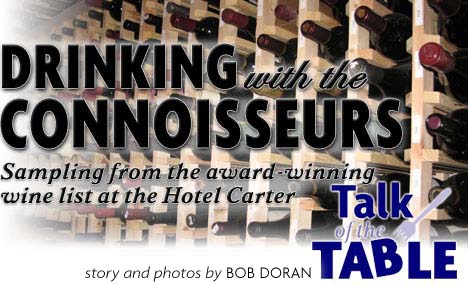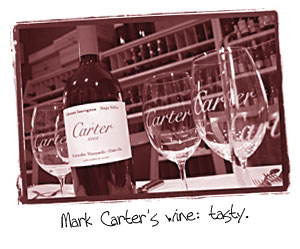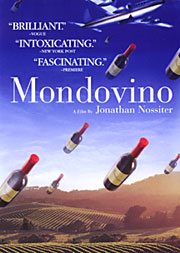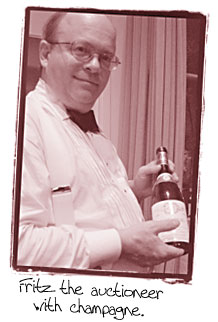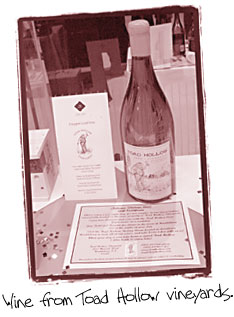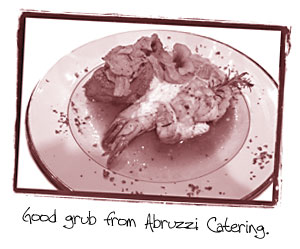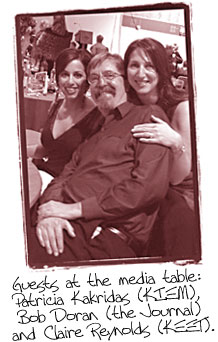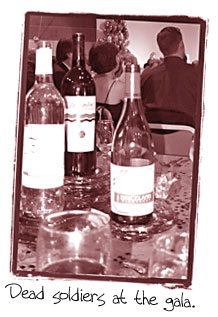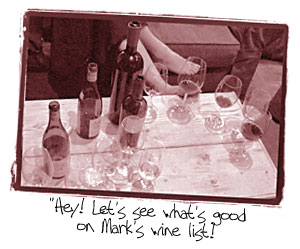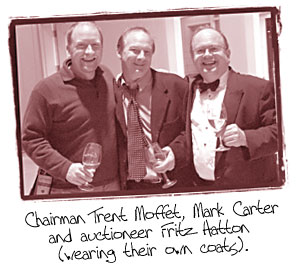|
COVER
STORY | IN THE NEWS | FROM THE PUBLISHER February 23, 2006
"We actually bought the first release of the Colgin and the Bryant Family the first year they came out, which was 1992," said Carter. "We were getting two to four cases and selling it like it was any other wine. We were even pouring it on our little `Wine on Wednesday' [tasting parties]. We didn't know it was going to become some $600 a bottle cult wine." Another factor that elevates the 301 list is a span of vintages -- from 1927 to the present, with strong holdings in wines from 1947, 1959 and 1961. Carter explained that he got in on the liquidation of a collection amassed by a Napa restaurateur, Bruce LeFavour, who heavily invested in '61s when they were new wines. "He paid just over $100 a case for these first growth Bordeauxes. At the time the distributor said, `Who do these people think they are, charging $100 for a case of wine?' Bruce didn't pay any attention to the guy. He bought all he could, put them away and ended up living off them for many, many years. Those $10 bottles are now $1,600 bottles. I didn't pay that much when we bought them something like 15 years ago, but that's what they're worth today." Burke noted that when the French dominated the world's fine wine market, "the style [of wine] was dramatically different from now. They were powerful wines that needed to [age] in cellars for a number of years before they were ready to drink." It's a far cry from the modern wine world. "The way we drink wine now, you can go to the store, buy a bottle and pop [the cork] that night. The style is very approachable, very easy to enjoy right off the bat. There's a lot more fruit; the grapes are [picked] riper. The wine is more accessible in its youth."
Parker fear factorThe '90s saw significant changes in the wine market in the United States. Consumers were buying more high-end wines and their palates were evolving -- from lighter, sometimes slightly sweet white wines and white zinfandels to bold, fruity reds. This shift was fueled by the rating system from publications like Wine Spectator and by wine writers, especially one wine critic: Robert Parker. Carter explained -- and the movie Mondovino dramatizes -- that Parker's influence on consumers is so great that winemakers have actually shifted their winemaking styles according to what Parker prefers -- bold, fruity, early-maturing, oaky wines. "Everybody wants a good rating," said Carter. "So they try to make a wine just for Parker to get a high score, and this happens anywhere in the world. It's no longer the terroir of the area, as it was with the old wine styles." (Terroir, a French term, translates as "soil," but it's a bit more nebulous. In wine lingo it refers not just to the type of soil the vines are grown in, but also the specific region where they're grown, down to the side of the hill they grew on -- sunny or shady -- as well as weather patterns and the care of the vines.) Carter said Parker can be pretty intimidating. He should know. In addition to his extensive wine collection, Carter also produces some wine under his own label, Carter Cellars, made by winemaker Nils Venge. He was at Saddleback Cellars where his wine is made during the crush last year; Parker was invited to come taste. "I got to say hello to him and watch him make his comments on the wines," Carter recalled. "Everybody marched up and showed their wines. He drank them and I listened to the whole conversation. [But] when the time came, I didn't show my wine. I almost did, then I thought, `I don't need to do this. I don't want to do this.' I pulled it back. It still scares the shit out of me -- I never put it on the table." Carter's sommelier, however, says he does not pay much attention to Parker or other critics when he is evaluating a wine. "My style in buying is different," Burke said. "I base my decision on: Do I think it's a quality wine? Does it have a place on the list where people will appreciate it? Then there are the economic factors: Is it a good value? Is it worth was they're aski-ng for it? "I think the job of any good buyer or a good sommelier is ultimately about making your own assessment. Often you are tasting before the ratings come out, so you have to judge the quality yourself. I think I have enough experience to judge if it's a quality wine. In the end it comes down to personal preference."
Gala, après galaA few weeks after my sit-down with Carter and Burke, a press release showed up from College of the Redwoods, an announcement of the annual Autumn Vintage Wine Gala, a formal dinner and auction at the Adorni Center that raises cash for the Hospitality Institute of the North Coast. Figuring it would be good for my wine education, I secured an invitation and I invited Margann to be my guest and guide. Dressed up in a burgundy shirt and a slightly frayed tuxedo coat, with Margann as designated driver, I made my way to the gala. Before dinner we perused the dozens of tasting tables that circled the room. As we sampled various vintages, we chatted with fellow tasters, wine company reps, wine buyers, local winemakers and many from out of county -- among them "Dr. Toad" of Toad Hollow. When the time came, we sat down for an excellent dinner overseen by Chef Todd Fisher of Abruzzi Catering and more wine: a Briceland Chardonnay 2001 with the marinated figs, a 2004 Fieldbrook Cortese with the spinach salad and, to accompany the main course (filet mignon topped with chanterelles and prawns skewered on rosemary twigs), a 2001 Livingston Moffett Cabernet Sauvignon, made by the event's honorary chairperson, Trent Moffett. I had a bidder's paddle for the post-dinner auction but didn't dare touch it, since the assembled high-rollers quickly sent the price of each lot beyond my price range, with encouragement from the event's genial auctioneer -- Fritz Hatton, a vintner who crafts premium Napa red blends under his Arietta label. After the various lots were sold, I lingered at our table sipping dessert wine. Margann drifted off and returned, excited: Dr. Toad had invited us to join him back at his hotel to taste an '82 Caymus cabernet. We should go, she said. I'll admit, I had no idea of the significance of that particular bottle of wine, but Margann did. We headed up the street to the Hotel Carter and walked into the ultimate post-auction tasting party.
Musical coatsI sat down next to Todd, settling into one of the same cushy chairs in the hotel lobby where I had talked with Mark and Thomas. (We were all on first-name basis by this time.) By the time we'd finished off the Caymus (94 points from Wine Spectator), he'd told me his life story, from running away from home on a motorcycle to becoming an non-credentialed doctor of wine in the Russian River Valley where, in his opinion, too many retired doctors deem themselves vintners. Mark opened up a few bottles of Carter Cellars wine. (I don't think he needed to fear Parker.) Other winemakers, who all seemed to be staying at the hotel, shared their wine. At some point Fritz the auctioneer, declared something along the lines of, "Hey, let's see what's good on Mark's wine list." Now, I'll admit, I'd already had quite a few glasses of wine, so my recollection of the details may be a bit hazy, but I believe his first choice was the Richebourg champagne -- a good place to start. We moved on through some very nice whites to the reds -- zippy zins and bold cabs -- some of which I assume were cult-like and some definitely "fruit bombs" a la Parker. Then there was the 1964 Château Lafite Rothschild, a far more subtle wine than anything we'd been drinking. After I swirled it around, stuck my nose in the glass as instructed and swished it around in my mouth, I could imagine the place it came from and taste the earth and the rain and sun that gave the vines life. One sip brought the whole terroir concept into much clearer focus. The wine flowed and along with it conversation. The size of the party waxed and waned as hotel guests, many had come to town specifically for the gala, filtered in, lingered and tasted, then headed for their rooms upstairs. I spoke with the gala's executive director, Ahn Fielding, about the secret to a successful fundraiser (a carefully cultivated guest list). At some point she suggested that it would be a good time for Mark, Fritz and Trent (the honorary chair) to go back to the Adorni to thank the staff still cleaning up and pick up the wine they'd left behind. The three winemakers grabbed their coats and took off walking. A moment or so later a hotel guest who had been drinking with us earlier returned from his room upstairs to retrieve his suit coat. There was one on the chair next to me, so I handed it to him. While it was dark in color, it wasn't his. Since it had been on the same chair where Mark and Fritz had picked up their coats, I guessed that one of them had grabbed the wrong one. The guest was in his stocking feet and couldn't exactly follow them, so I volunteered and took off for the Adorni. I found the vintners sipping more wine and asked Fritz if he was perhaps not wearing his own coat. He agreed, he was not. But the coat I was carrying was not his either. It turned out Fritz was wearing Mark's coat, Mark had on the guest's coat. After a little musical coats dance, I helped gather up the remaining bottles for the return trip. Walking back I examined the bottle I was carrying from Fritz's winery, Arietta. When I asked about the bars of music on the label, he noted that he's also a classical music connoisseur, and explained that an arietta is a short aria from an opera. He proceeded to illustrate by singing one, loudly, as we strolled up the street, warmed by the afterglow of all that fine wine. Do expensive wines get you just as intoxicated as less costly vintages? Well, yes they do.
COVER
STORY | IN THE NEWS | FROM THE PUBLISHER Comments? Write a letter! © Copyright 2006, North Coast Journal, Inc. |

